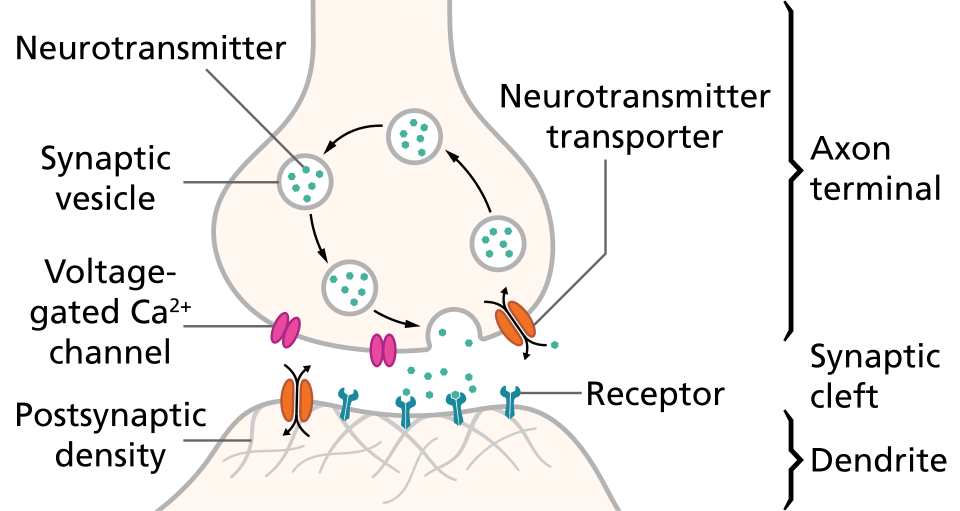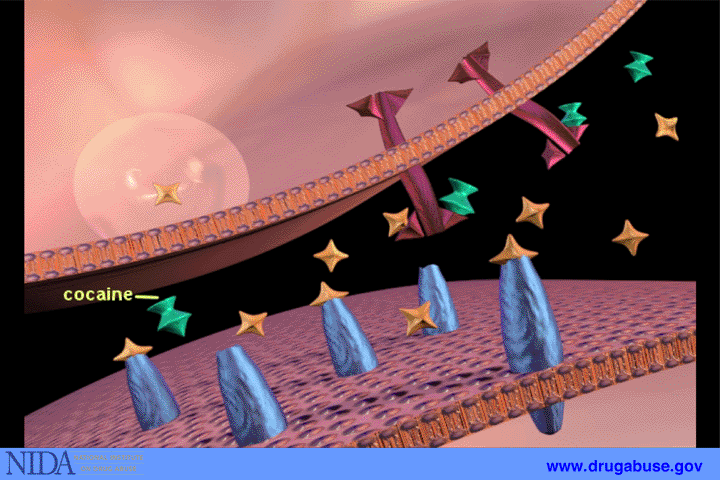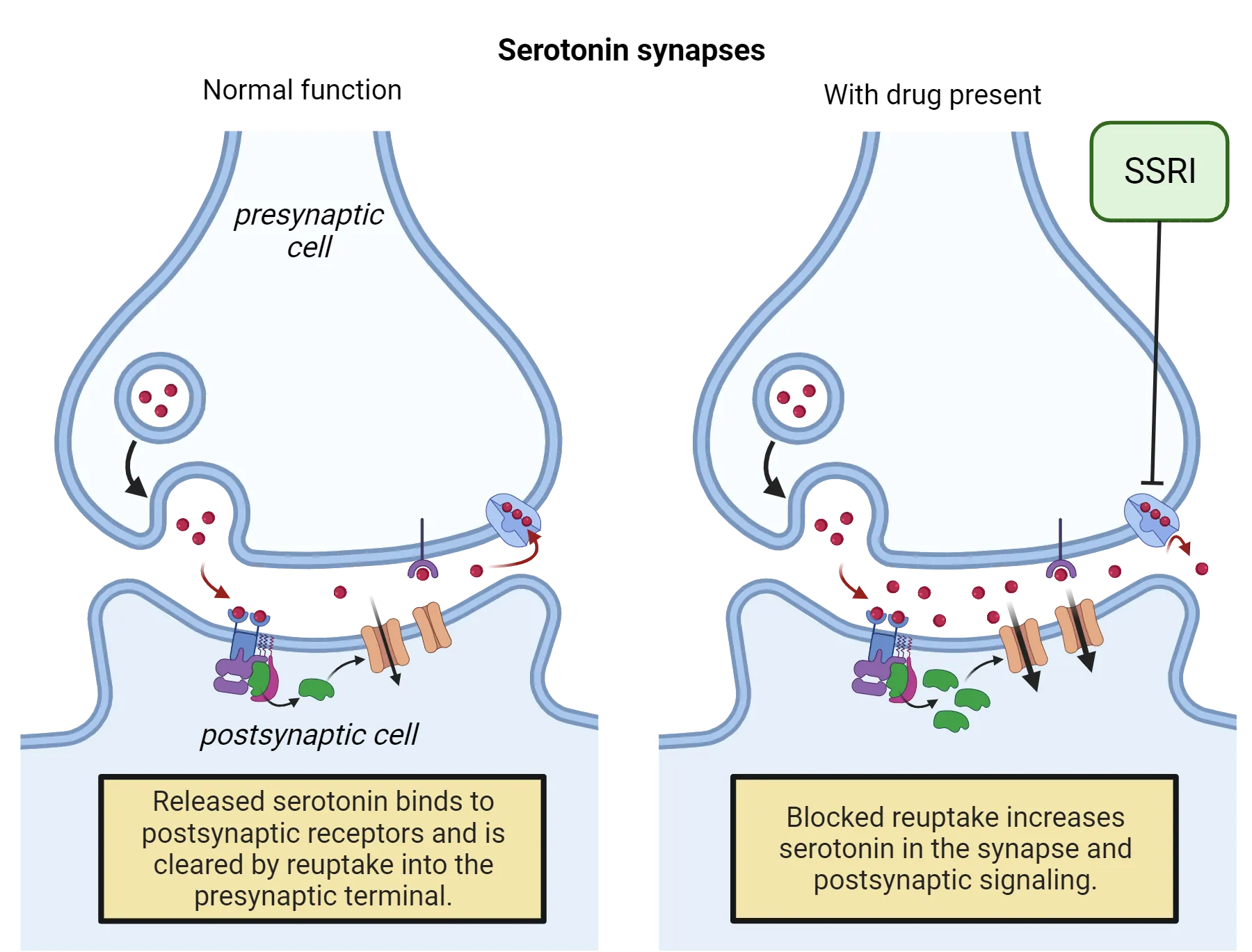IB Syllabus focus:
'- Steps in neurotransmission
- Role of receptors and synapses
- Impact of drugs on transmission'
Synaptic transmission is an intricate process that permits neurons to pass signals to other neurons, muscles, or glands. By delving deeper into this mechanism, one can truly grasp the essence of neural communication. Understanding the localisation of function within the brain is fundamental to comprehending how specific areas are involved in synaptic transmission.
Steps in Neurotransmission
1. Neuron Activation
Every synaptic transmission commences with the activation of a neuron. This is initiated by a stimulus, such as a sensory input or a chemical signal.
Once activated, the neuron generates an electrical signal termed an action potential.
This action potential swiftly travels down the neuron's axon, moving towards the terminal buttons, or synaptic terminals. The concept of neuroplasticity highlights the brain's ability to adapt and reorganise itself, including the way neurons activate and communicate.
2. Release of Neurotransmitters
Upon reaching the terminal buttons, the action potential instigates calcium channels to open.
Calcium ions then flow inside, triggering vesicles containing neurotransmitters to fuse with the presynaptic membrane.
This fusion prompts these chemical messengers, or neurotransmitters, to be released into the synaptic cleft. Neurotransmitters like dopamine and serotonin play pivotal roles in this process, influencing mood, emotion, and other physiological functions.

This schematic shows a typical chemical synapse: neurotransmitter-filled vesicles in the presynaptic terminal, diffusion across the synaptic cleft, binding to receptors, and clearance via reuptake. Labels are minimal yet precise, matching IB Psychology depth on transmission and receptor action. Some structures (e.g., cytoskeletal elements) exceed syllabus depth but do not distract from the core process. Source.
3. Crossing the Synaptic Cleft
The synaptic cleft is the minuscule space between neurons, where neurotransmitters journey chemically.
The neurotransmitters cross this gap, propelled by diffusion, aiming to bind with postsynaptic receptors.
4. Binding to Receptors
Each neurotransmitter is specifically shaped to bind with certain receptors on the postsynaptic neuron's membrane.
When a neurotransmitter successfully binds, it alters the shape of the receptor and thus its function.
This binding instigates a cascade of internal events within the postsynaptic neuron.
5. Initiation or Inhibition of a New Action Potential
The end result of neurotransmitter-receptor binding can either be excitatory or inhibitory.
An excitatory response makes the postsynaptic neuron more likely to produce its own action potential.
Conversely, an inhibitory response reduces this likelihood, acting as a "brake" to neuronal activity.
6. Termination
The communication is short-lived. To terminate the signal and ready the synapse for future signals, the neurotransmitter's effect must end.
Some neurotransmitters get broken down by enzymes, while others undergo reuptake by the presynaptic neuron. Reuptake involves neurotransmitters being absorbed back into the neuron from which they were released. Understanding the genetic basis behind neurotransmitter release and action, as discussed in twin studies, can shed light on the hereditary aspects of these processes.
Role of Receptors and Synapses
Receptors
Function: These are specialised protein structures embedded in the postsynaptic membrane. They detect and respond to neurotransmitters.
Types: Different receptors respond to different neurotransmitters. For instance, dopamine receptors specifically detect dopamine.
Modulation: Some drugs can modify how receptors work, either enhancing or inhibiting their function.
Synapses
Definition: Synapses are the functional junctions between two neurons, vital for communication.
Chemical vs. Electrical: The majority of synapses in the human nervous system are chemical, but electrical synapses also exist, allowing for direct current flow between neurons.
Plasticity: Synapses aren't fixed; they can strengthen, weaken, or even form anew based on experiences. This phenomenon underlies learning and memory.
Impact of Drugs on Transmission
Agonists and Antagonists
Agonists: These are substances that bolster the effect of a neurotransmitter. They can either imitate the neurotransmitter, thereby binding and activating its receptor, or amplify the amount of neurotransmitter released.
Antagonists: These are substances that diminish or block the effect of a neurotransmitter. They might bind to the receptor without triggering it, effectively stopping it from being activated by the actual neurotransmitter. Alternatively, they can reduce the quantity of neurotransmitter synthesised.
Examples of Drugs and Their Effects
1. Cocaine and Dopamine:
Cocaine obstructs dopamine reuptake, increasing its concentration in the synaptic cleft, leading to prolonged pleasurable sensations.

Illustration of cocaine binding to dopamine transporters (DAT), thereby preventing dopamine clearance and causing synaptic buildup and persistent postsynaptic stimulation. This visual exemplifies a reuptake blocker’s effect at the synapse. Artistic styling is more illustrative than anatomical, but the labeling accurately depicts the mechanism. Source.
2. SSRIs (Selective Serotonin Reuptake Inhibitors) and Serotonin:
SSRIs, such as fluoxetine, are commonly used for depression and anxiety disorders.
They hinder the reuptake of serotonin, raising its levels in the synaptic cleft, which can alleviate depressive symptoms.

The diagram contrasts normal serotonin clearance with SSRI action: blocking the serotonin transporter (SERT) increases serotonin in the cleft and enhances postsynaptic signaling. This aligns with the IB requirement to explain drug effects at the synapse. Minor references to broader therapeutic timelines on the page exceed syllabus scope but the figure itself focuses on mechanism. Source.
3. Caffeine and Adenosine:
Caffeine acts antagonistically towards adenosine receptors.
By obstructing these receptors, caffeine counters the sensation of drowsiness, ushering in alertness.
4. Opioids and Endorphins:
Opioids, like morphine, resemble endorphins – the body's natural painkillers.
They bind to endorphin receptors, minimising pain perception and inducing euphoria. Overuse, however, can lead to addiction.
Implications of Drug Use
Drugs can have both therapeutic and deleterious effects on synaptic transmission.
Proper understanding aids in the development of effective treatments and recognising potential side effects or addiction risks.
Chronic drug use can lead to lasting alterations in synaptic transmission patterns, potentially underpinning addiction and other neurological and psychiatric disorders.
FAQ
Absolutely. Changes at the synaptic level can have profound implications for an individual's behaviour or mental state. Alterations in the amounts or types of neurotransmitters, or in their receptors, can affect mood, cognition, and behaviour. For instance, a decrease in serotonin levels at synapses has been associated with depressive moods. Additionally, synaptic plasticity, where synapses strengthen or weaken over time, underpins learning and memory. Abnormal synaptic changes or malfunctions can lead to various neurological or psychiatric disorders. Hence, understanding synaptic transmission is pivotal in both neuroscience and the broader field of psychology.
Synaptic pruning is a natural and essential process where the brain eliminates extra synapses, streamlining its neural connections. During early childhood, the brain undergoes rapid synapse formation, leading to an overabundance of neural connections. However, not all these connections are beneficial or efficient. Synaptic pruning ensures that only the most useful and frequently used synapses remain, whilst less active or unnecessary ones are removed. This process is crucial for the efficient functioning of the nervous system, refining neural pathways and ensuring optimal processing. It also plays a role in learning and memory consolidation, as stronger and more frequently used connections are reinforced.
Neurotransmitter imbalances within the synaptic cleft can lead to a range of physiological and psychological effects. If there's an overabundance or scarcity of a particular neurotransmitter, it can disrupt the balance of excitatory and inhibitory signals, potentially causing or contributing to mental health disorders. For example, a deficit in serotonin is often associated with depression, while an excess of dopamine is linked to schizophrenia. Parkinson's disease is related to a decrease in dopamine in specific brain regions. Imbalances can also result from drug use, where substances artificially increase or decrease neurotransmitter levels, leading to addiction, dependence, or withdrawal symptoms. Proper balance is thus essential for health and well-being.
Toxins and poisons can seriously disrupt synaptic transmission. Some toxins act by blocking the release of neurotransmitters, hence preventing the signal's transfer across synapses. For instance, botulinum toxin (found in botulism) prevents the release of acetylcholine at neuromuscular junctions, leading to muscle paralysis. Others, like snake venom, might break down neurotransmitters in the synaptic cleft or block receptors, inhibiting their normal function. There are also toxins that cause an over-release of neurotransmitters, leading to constant stimulation and potential neuron damage. Understanding these effects is essential in both medical treatment and the development of potential antidotes.
Neurotransmitters don't endlessly stimulate a neuron due to termination mechanisms that ensure the synaptic signal is brief. Two primary mechanisms are enzyme degradation and reuptake. In enzyme degradation, specific enzymes break down the neurotransmitter in the synaptic cleft, rendering it inactive. For example, the enzyme acetylcholinesterase breaks down acetylcholine. In reuptake, the neurotransmitter molecules are reabsorbed into the presynaptic neuron for repackaging or recycling. This clears the synaptic cleft and prepares it for future neurotransmission. Such mechanisms ensure precise timing of neural signals and avoid continuous, non-stop stimulation.
Practice Questions
Synaptic transmission begins with the activation of a neuron, leading to the generation of an action potential. This action potential travels down the neuron's axon to its terminal buttons, where it instigates the release of neurotransmitters into the synaptic cleft. These neurotransmitters then cross the cleft, aiming to bind with specific receptors on the postsynaptic neuron. Receptors play a pivotal role as they detect the neurotransmitters, initiating a response within the postsynaptic neuron, either exciting or inhibiting it. Their importance lies in mediating the neuron's response, ensuring precise communication and functioning of the neural network.
Drugs can profoundly influence synaptic transmission by altering the quantity or function of neurotransmitters. Agonists enhance the effects of neurotransmitters; they can mimic them, binding and activating receptors, or increase neurotransmitter release. In contrast, antagonists diminish or obstruct neurotransmitter effects. They may bind to receptors without activating them, thereby blocking their action, or reduce neurotransmitter synthesis. The implications of these actions are significant. Agonists can amplify natural responses, leading to heightened sensations or feelings, while antagonists can suppress or modify natural responses. Their understanding is vital in therapeutic contexts and in acknowledging the risks associated with misuse.

